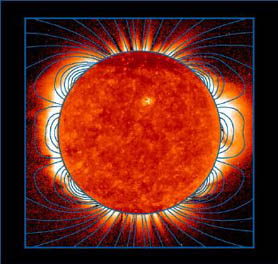|
INTRODUCTION
MAGNETIC FIELDS
CMES AND FLARES
MAGNETIC MODELING
FORECASTERS
HOME
|
Astronomical Magnetic Fields
Although we cannot see them, magnetic fields are all around. Magnetic interactions occur between objects in which electrons can move freely. The magnet that
holds paper to your refrigerator does so because it has a magnetic field. As you bring a refrigerator magnet close to the refrigerator door you should feel it pulling
towards the door even before it comes in contact. This is possible because the magnetic field which interacts with the refrigerator door extends out from the
magnet itself. The field is strongest close to the magnet and becomes weaker as you get farther from the magnet.
|
Although we cannot see magnetic fields directly, there are many ways to
observe evidence of them. In the picture to the right iron filings have
been sprinkled around a bar magnet. The iron filings outline the magnetic
field lines, making it visible. Magnetic fields all have a pair of "poles",
from which "lines of force" or magnetic field lines appear to originate.
By connecting the dots made by the iron filings in this picture, you would
see the loops or arcades that extend between the poles on the two ends of
the bar magnet. These poles may be called positive and negative poles.
|

|

Image Credit: NASA
|
Traditional magnets are not the only place to find magnetic fields.
The Earth, other planets, and many stars, all have magnetic fields.
Our Sun has a complicated magnetic field which solar scientists are
trying to understand because of both its scientific importance and
practical value for all of us living in the solar system. |
|
The Earth has a magnetic field which looks like the field of
a large bar magnet, with positive and negative poles at the
South pole and the North pole. On the Sun, magnetic field is
associated with sunspots which usually appear in pairs or in
larger groups with both positive and negative members. In
addition to many complicated magnetic structures, the Sun
has polar magnetic fields like the Earth's that flip polarity
every 11 years as it goes through its sunspot cycle. The images
to the right show a basic outline of the magnetic fields of the
Earth and Sun.
|
 Image Credit: M. Guhatkatura et al.
Image Credit: M. Guhatkatura et al.
|
PAGE:
1
2
3
4
5
|

